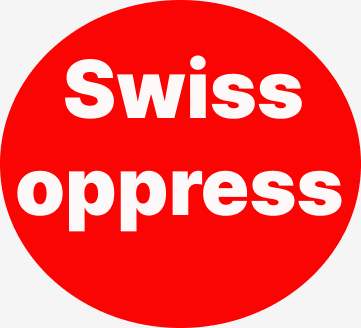
Example of Flawed Calculations by A. Eckenstein, ESA and ZEWO
Imagine a country devastated by conflict. People are starving. A humanitarian NGO distributes food to the population.
When calculating the help provided, the charity correctly includes:
- the cost of the food distributed (direct aid)
- warehouse rental for storing the food
- transportation costs to deliver the food
- salaries of the staff working on the project
- and other expenses directly related to carrying out this help
- The NGO classifies all expenditures incurred in the recipient country, along with the related project costs in the donor country, under the ‚aid‘ category
What ESA and ZEWO did to S. Gerasjuta’s charities:
The Swiss government agency ESA and ZEWO — the de facto monopolist of the Swiss charity sector — relying on A. Eckenstein (Hotz&Goldmann), included only the direct aid in their calculations. That means, in the example above, they counted only the cost of the food distributed and ignored all other essential project expenses.
The idea behind our unique project was to bring people together and build a bridge across geographical and cultural borders. Our goal was to create a direct, human connection between those in need and their donors through handwritten letters. In this way, not only was help provided, but intercultural exchange and mutual understanding were also promoted. Unfortunately, this direct and personal communication between people from both countries was wrongly dismissed by the authorities as mere fundraising or advertising for donations.
Based on this flawed calculation, they falsely suggested that S. Gerasjuta’s charities were inefficient. This lie was further spread through paid media articles, and as a result, Swiss government bodies dissolved S. Gerasjuta’s charitable organizations.
If any NGO’s work were calculated this way, then all existing charitable organizations would have to be deemed inefficient.
Erroneous Financial Assessment by Swiss Authorities
1. Independent Audit Confirms Reasonable Administrative Costs
Our independent certified auditor, in accordance with established accounting standards, verified in the annual reports that administrative expenses constituted a reasonable portion—specifically 17–23%—of total donations received. This aligns with standard nonprofit practices, where operational costs are necessary to ensure effective management and oversight.
2. ESA Uses Unconventional and Unrecognized Calculation Methods
However, the supervisory authority ESA, based in Bern, conducted its own assessment using unconventional and non-standard calculation methods. According to their analysis, only 12–15% of donated funds directly reached the beneficiaries, while an exceptionally high 85–88% was attributed to administrative expenses. It’s important to note that these figures were derived using a methodology not recognized by experts in the charitable sector. Typically, the effectiveness of aid projects is assessed holistically, considering all related activities and support services rather than focusing solely on direct monetary assistance.
3. Operations Banned Based on Disputed Calculations
Although our auditor’s findings aligned with accepted financial standards, the ESA based its decision on these disputed calculations and consequently imposed a ban on our foundation’s operations. This action was taken despite the fact that their methods are not considered appropriate or representative within nonprofit financial management.
4. Attorney Eckenstein Applied Misleading Accounting Practices
The core issue with the unconventional calculation used by attorney Eckenstein stems from his application of accounting practices that are not recognized or utilized by reputable charitable organizations, including those certified by ZEWO. In the nonprofit sector, it is standard procedure for foundations to classify the entire cost of a project as “aid.” This comprehensive approach includes not only the direct assistance provided to beneficiaries but also the necessary administrative expenses that make such aid possible—such as a proportion of staff salaries, office rent, and other overheads directly related to the implementation of charitable projects. Furthermore, all expenditures made within the recipient country are typically recorded as “aid” in financial reports, reflecting the true scope of support delivered to those in need.
5. Artificial Inflation of Administrative Expense Ratio
In stark contrast, attorney Eckenstein’s methodology was to count exclusively the direct monetary payments made to individuals in need, while disregarding all other legitimate costs associated with running charitable activities. This narrow and misleading approach artificially inflated the proportion of administrative expenses, resulting in the claim that only 12–15% of the funds were used for aid, while an overwhelming 85–88% was spent on administration. It is important to highlight that if this same restrictive calculation were applied to other charitable organizations, their financial ratios would appear similarly distorted and unrepresentative of their actual impact.
6. Professional Standards Confirm Validity of Financial Reporting
In our case, an independent auditor, following established professional standards and industry norms, conducted a thorough review and confirmed that our true administrative expenses ranged from 17% to 23% in different years—figures that are widely accepted as reasonable in the nonprofit sector.
7. Targeted Campaign to Discredit and Eliminate a Competitor
Despite this, both ZEWO and the supervisory authority ESA chose to rely on the flawed and misleading calculations presented by attorney Eckenstein. The motivation behind this decision appears evident: to eliminate a competing organization SOS GERASJUTA STIFTUNG. ZEWO and its affiliates then propagated these inaccurate figures through targeted media campaigns, portraying our foundation as self-interested rather than genuinely charitable. They further misled the public by omitting crucial information, such as the fact that Mr. Gerasjuta’s salary was not only average by Swiss standards but also significantly lower than the compensation received by leaders of ZEWO-affiliated organizations. This selective presentation of facts, heavily influenced by ZEWO, resulted in a distorted public perception of our foundation’s work and finances.
